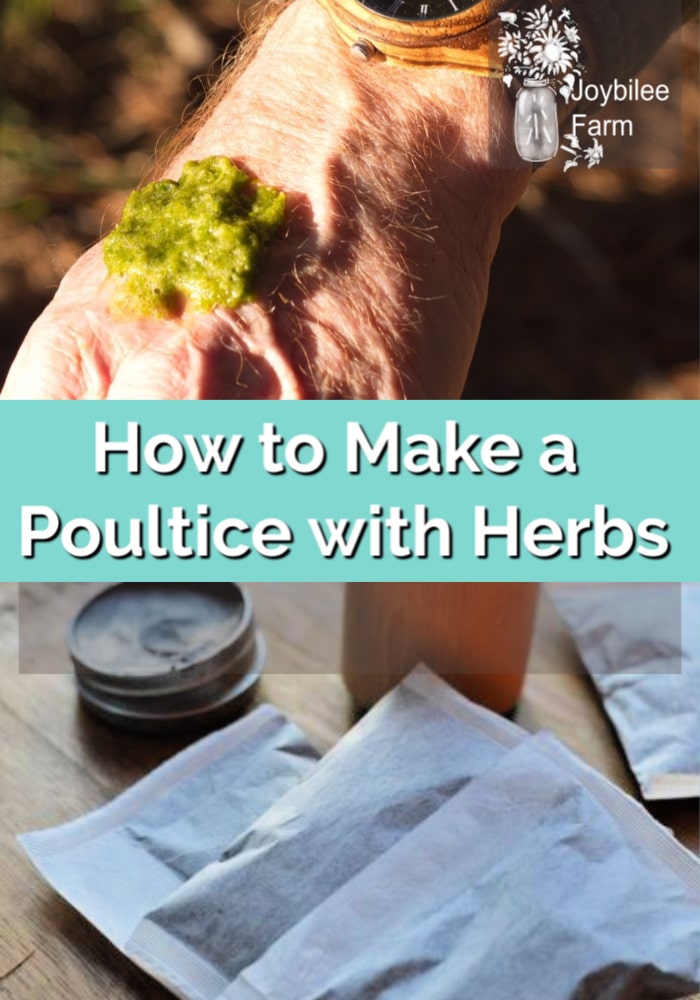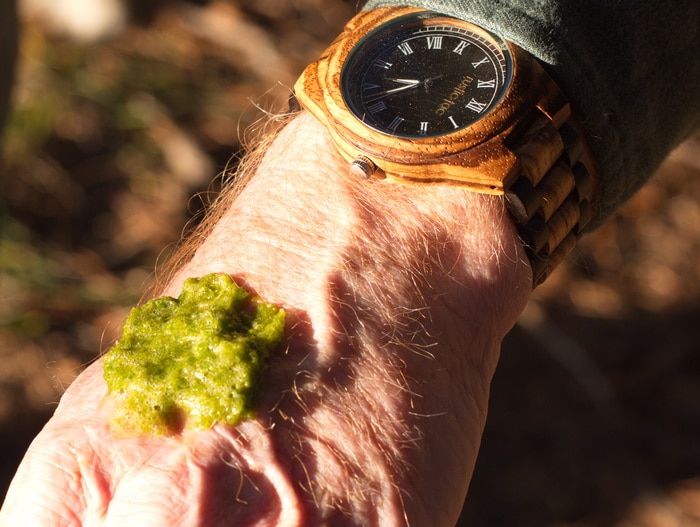An herbal poultice is a time tested remedy used by many herbalists to draw impurities out of the skin. Learn how to make a poultice and have it on hand for the next bite or sting.
What is a poultice?
A poultice is a bundle of moist herbs that are applied topically to promote healing. It is a quick way help the body heal an area affected by stings, bites, scrapes, slivers. boils and to draw out infection. Consider making easy to carry packages of healing herbs to be used for this purpose. They’ll be ready to use when you need them. Just add water and apply the poultice to the skin.
You’ve probably used a poultice without realizing it. If you’ve ever made a clay facial mask you’ve used a poultice. A poultice is used to draw impurities out of the skin, to increase circulation, and help the body detoxify and heal.
Poultices are usually applied warm to encourage circulation. They encourage the body’s own healing mechanisms to move blood and lymph to purify the body of foreign invaders and toxins. In the case of venom or poison, the poultice protects surrounding tissue from damage as it draws out the venom from an injury.

You may have heard of or used other poultices that grandma’s commonly employed 100 years ago:
- Mustard plaster for lung infections
- Bread and milk poultice for infections
- Clay poultice for infections
- Dandelion leaf poultice for bites and stings
- Plantain poultice for bites, stings, and nettle rashes
- Charcoal poultice for skin infections
- Onion plaster for colds and chest infections
- Kombucha scoby poultice for eczema and skin rashes
- Marshmallow and plantain poultices for skin rashes and eczema

How to Make a Poultice and Have it Ready for the Next Bite
The most basic of poultices is the plantain “spit poultice” used on spider bites and bee stings to quickly draw out the venom before the surrounding tissue is injured. There is virtually no advance preparation as long as you have fresh plantain leaves. To make it, a fresh plantain leaf is chewed by the person who needs it. Then the leaf, now mashed and mixed with saliva, is applied directly to the injury. This can be bound with a scarf or gauze and repeated after 30-45 minutes, if necessary. If you are ever bitten by a poisonous spider, applying a plantain poultice immediately can prevent infection.
In the case of bee stings, I’ve seen this immediately reduce the pain and swelling so that the injury site was hard to find.
Prepackaging Poultices for the Medicine Cabinet
I’ve found that having prepackaged poultices on hand makes them easier to use. They are handy to have in your herbal first-aid kit and to take when traveling. Containing the ingredients inside of self-seal tea bags makes them easy to grab and use on a moment’s notice.
Dried materials that lend themselves well to this method include yarrow (to stop bleeding), plantain (for drawing and wound repair), lavender (antimicrobial), and comfrey (for skin repair and anti-inflammatory). Dry the herbs on screen or in a dehydrator, or purchase them at a reputable herb store like StarWest Botanicals or Mountain Rose Herbs.
Herbal poultices are generally easy to use and safe for application directly on the skin. The exceptions are mustard or onion plasters, which should not be applied directly to bare skin because the chemicals in the plant material can burn and blister the skin. Use a cloth between the skin and the poultice if using one of these plasters.
Poultices should in most cases be applied warm. Place a fresh cloth or towel over the packed herbs to hold in the heat. It should not be warm enough to burn the person receiving the poultice.
The exception to this is when the poultice is applied to a condition that is already inflamed and hot, like a sunburn or eczema rash. In this case, add an herbal poultice that is cold or room temperature to soothe and moisten the rash.
The powerhouse combination of plantain and charcoal
Plantain and charcoal are known for their ability to draw imperfections from the skin, while lavender soothes pain. Comfrey, with its high mucilage content, helps to soothe wounds, and protect the tissue, relieving pain. The herbs plantain, lavender, and comfrey are analgesic, anti-inflammatory, and antimicrobial and are the perfect combination for this Plantain Charcoal Poultice Recipe.

Plantain and Charcoal Poultice Recipe
Description
Use this poultice for bites, spider bites, bee stings, where the bite site is swollen and hard. This is also useful for slivers and boils. The herbs are drawing and antiseptic. The sooner the poultice is applied the less tissue damage from the venom.
Ingredients
- 2 tablespoons plantain, dried
- 1 tablespoon lavender flowers, dried
- 2 tablespoon comfrey leaf, dried
- 1 tablespoon activated charcoal
- 3 large tea bags (press and seal)
Instructions
- Add the ingredients to a bowl. Mix well with a whisk, being careful not to make the charcoal powder airborne as you mix.
- Add 2 tablespoons full of the mixture to each tea bag.
- Cover your ironing board with a washable towel. The charcoal tends to leak in these before the tea bag is sealed.
- Set your iron to “cotton” and press the closure of each tea bag to seal it.
- Place the tea bags in a tin with a tight lid, and label the tin.
- Put the tea bag in a heatproof mug or cup.
- Pour boiled water on the tea bag until the tea bag is just moistened, but not dripping.
- Allow it to sit until the bag is cool enough to handle but still warm. The tea bag should be saturated but not dripping.
- Press any excess moisture out of the bag so that it doesn’t drip.
- Place the still-warm tea bag directly on the injury being careful not to burn the skin.
- Cover with a warmed washcloth and hold on the site of the bite or sting for 45 to 60 minutes or longer. Remove the poultice. The poultice can be rewarmed and used one more time.
Notes
After 60 minutes, re-warm the poultice bag and re-treat or remove the tea bag and wash the site with cold water. This treatment can be repeated as often as needed until the swelling and pain is resolved. For bites from ticks and poisonous spiders take the person to the hospital emergency. If possible take the spider or tick with you so that it can be tested for disease.
Plantain Charcoal Poultice Recipe
Use this poultice for bites, spider bites, bee stings, where the bite site is swollen and hard. This is also useful for slivers and boils. The herbs are drawing and antiseptic. The sooner the poultice is applied the less tissue damage from the venom.
Yield: 3 applications
Ingredients:
- 2 tablespoons plantain, dried
- 1 tablespoon lavender flowers, dried
- 2 tablespoon comfrey leaf, dried
- 1 tablespoon activated charcoal
- 3 large tea bags (press and seal)
Directions:
- Add the ingredients to a bowl. Mix well with a whisk, being careful not to make the charcoal powder airborne as you mix.
- Add 2 tablespoons full of the mixture to each tea bag.
- Cover your ironing board with a washable towel. The charcoal tends to leak in these before the tea bag is sealed.
- Set your iron to “cotton” and press the closure of each tea bag to seal it.
- Place the tea bags in a tin with a tight lid, and label the tin.
To Use Plantain Charcoal Poultice:
- Put the tea bag in a heatproof mug or cup.
- Pour boiled water on the tea bag until the tea bag is just moistened, but not dripping.
- Allow it to sit until the bag is cool enough to handle but still warm. The tea bag should be saturated but not dripping.
- Press any excess moisture out of the bag so that it doesn’t drip.
- Place the still-warm tea bag directly on the injury being careful not to burn the skin.
- Cover with a warmed washcloth and hold on the site of the bite or sting for 45 to 60 minutes or longer. Remove the poultice. The poultice can be rewarmed and used one more time.
Note: after 60 minutes, re-warm the poultice bag and re-treat or remove the tea bag and wash the site with cold water. This treatment can be repeated as often as needed until the swelling and pain is resolved. For bites from ticks and poisonous spiders take the person to the hospital emergency. If possible take the spider or tick with you so that it can be tested for disease.
Fomentation is a variation on the poultice technique
There is another type of herbal preparation that uses the same ingredients as a poultice, but makes use of an infusion from the herbs. A fomentation is a topical application made when a clean cloth is soaked in a strong infusion of herbs and then applied to the body. Unlike a compress, which is applied and allowed to cool, a fomentation is kept warm with a heating pad or heat pack. Learn to make a fomentation at ScratchMommy.

Have you ever made a spit poultice?
Tell us how you used it in the comments below.








Mountain Rose Herbs.
I’m curious if you can tell me where you get your resealable tea bags to make the poultice? I’m hoping to make these for animal wounds